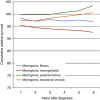Relative survival of patients with non-malignant central nervous system tumours: a descriptive study by the Austrian Brain Tumour Registry
- PMID: 24253501
- PMCID: PMC3899758
- DOI: 10.1038/bjc.2013.714
Relative survival of patients with non-malignant central nervous system tumours: a descriptive study by the Austrian Brain Tumour Registry
Abstract
Background: Unlike malignant primary central nervous system (CNS) tumours outcome data on non-malignant CNS tumours are scarce. For patients diagnosed from 1996 to 2002 5-year relative survival of only 85.0% has been reported. We investigated this rate in a contemporary patient cohort to update information on survival.
Methods: We followed a cohort of 3983 cases within the Austrian Brain Tumour Registry. All patients were newly diagnosed from 2005 to 2010 with a histologically confirmed non-malignant CNS tumour. Vital status, cause of death, and population life tables were obtained by 31 December 2011 to calculate relative survival.
Results: Overall 5-year relative survival was 96.1% (95% CI 95.1-97.1%), being significantly lower in tumours of borderline (90.2%, 87.2-92.7%) than benign behaviour (97.4%, 96.3-98.3%). Benign tumour survival ranged from 86.8 for neurofibroma to 99.7% for Schwannoma; for borderline tumours survival rates varied from 83.2 for haemangiopericytoma to 98.4% for myxopapillary ependymoma. Cause of death was directly attributed to the CNS tumour in 39.6%, followed by other cancer (20.4%) and cardiovascular disease (15.8%).
Conclusion: The overall excess mortality in patients with non-malignant CNS tumours is 5.5%, indicating a significant improvement in survival over the last decade. Still, the remaining adverse impact on survival underpins the importance of systematic registration of these tumours.
Figures




References
-
- Bauchet L, Rigau V, Mathieu-Daude H, Figarella-Branger D, Hugues D, Palusseau L, Bauchet F, Fabbro M, Campello C, Capelle L, Durand A, Tretarre B, Frappaz D, Henin D, Menei P, Honnorat J, Segnarbieux F. French brain tumor data bank: methodology and first results on 10,000 cases. J Neurooncol. 2007;84:189–199. - PubMed
-
- Boskos C, Feuvret L, Noel G, Habrand JL, Pommier P, Alapetite C, Mammar H, Ferrand R, Boisserie G, Mazeron JJ. Combined proton and photon conformal radiotherapy for intracranial atypical and malignant meningioma. Int J Radiat Oncol Biol Phys. 2009;75:399–406. - PubMed
-
- Burger EH, Groenewald P, Bradshaw D, Ward AM, Yudkin PL, Volmink J. Validation study of cause of death statistics in Cape Town, South Africa, found poor agreement. J Clin Epidemiol. 2012;65:309–316. - PubMed
-
- Chen CM, Huang AP, Kuo LT, Tu YK.2011Contemporary surgical outcome for skull base meningiomas Neurosurg Rev 34281–296.discussion 296. - PubMed
-
- Cho H, Howlader N, Mariotto AB, Cronin KA.2011Estimating relative survival for cancer patients from the SEER Program using expected rates based on Ederer I versus Ederer II method. Surveillance Research Program NCI Technical Report #2011-01Available at www.surveillance.cancer.gov/reports/ .
MeSH terms
LinkOut - more resources
Full Text Sources
Other Literature Sources

